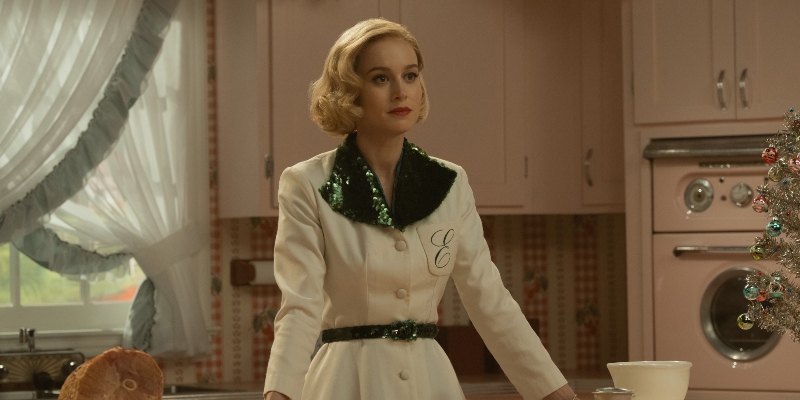
When it comes to novel adaptations, most readers I know fall into one of two camps: they either refuse to watch them, or they can hardly wait. The first group wishes to preserve the written form of the story in their minds, uncorrupted by anyone else’s vision, while the second is more open. Like parents of multiple children, their hearts simply expand to include the completely new but related work of art.
Personally, I teeter on the fence between these camps. I usually end up watching the screen adaptations of books I read because I just can’t resist—even though I’m not a relaxed, open-minded viewer, but an uptight and wary one, unable to watch without keeping a running tally of the differences between the adaptation and the book. Sure, I understand that the adaptation will necessarily diverge from the book in ways that I might not like. It might even diverge in ways that I truly love. And yet, I can’t help hoping it won’t, at all.
The new Apple TV+ adaptation of Lessons in Chemistry was no exception to the rule. I’m one of the many readers who loved Bonnie Garmus’s novel and its heroine, Elizabeth Zott, a brilliant research chemist and the reluctant, revolutionary star of Supper at Six, the most popular cooking show in Garmus’s mid-century America.
If you’re wondering if Lessons in Chemistry is “just like” the book, I’m sorry to tell you, it’s not. Not entirely.
But I loved what they did with it. Mostly. Maybe you will, too.
In some ways, the series is even more enjoyable than the book—like the setting, for example. As with Mad Men, Lessons in Chemistry captures America as it was in the 1950s and 60s. The clothes! The hair! The billboards! The cars! The furniture! I could watch it all again with the sound turned off and be completely entertained.
The casting and acting is also superb, in my humble opinion. Most of the actors faithfully represent the characters created by Garmus, complete with their mannerisms, personalities, and motivations. Brie Larson, as Elizabeth, is just as beautiful, brilliant, and matter-of-fact as she is on the page. Her daughter, Madeline (Alice Halsey), is as adorable and precocious. Calvin Evans (Lewis Pullman) is perhaps a little more handsome than his print counterpart (not that I’m complaining). Kevin Sussman is pitch-perfect as Elizabeth’s producer, the diffident, hapless, and goodhearted Walter. And Rainn Wilson as the vile TV studio executive, Phil Lebensmal? Inspired.
If you’re wondering if Lessons in Chemistry is “just like” the book, I’m sorry to tell you, it’s not. Not entirely.
The screenwriters also did an admirable job of capturing the complexity of the plot without sacrificing clarity or pacing. I’m not surprised that they found it necessary to simplify some of the storylines and conflate some of the characters; Elizabeth’s storyline is only one of many intersecting narrative arcs in the novel, and all of the book’s supporting characters are well-developed with complex backstories and perspectives. I was generally pleased with how much they managed to pack in.
Without spoiling too much for my fellow readers and viewers, I’ll say the love story between Elizabeth and Calvin—their progression from enemies to lab partners to soulmates—is just as emotionally satisfying as it is in the novel, and as well informed by their individually traumatic histories. Madeline’s search for the truth about her father makes it on to the screen, and her findings line up exactly with those in the novel. Calvin’s friendship with the Reverend Wakely, and a slightly less provocative version of his spiritual journey, makes the cut, too. And I absolutely loved how they chose to represent the storyline of Six-Thirty, the Goldendoodle voiced by BJ Novak.
Really, there were only two characters, and storylines, that I had mixed feelings about.
I’ll begin with the one that was simply a disappointment: Fran Frask. In the novel, she is a “too cheerful, wide-bottomed secretary,” who later gets fired by her (young, idiotic, male) supervisor for gaining weight. She also gets dumped by her boyfriend for a younger, thinner, less sexually experienced woman. At the ripe old age of 33 in the 1960s, she’s basically destined for spinsterhood. We can’t blame her for bitterly resenting Elizabeth, who has the relationship and the professional success she so desires for herself, though we can (and do) judge her for openly sabotaging Elizabeth’s career. We expect the pair to be lifelong enemies, but instead, they bond over a shared trauma and become allies.
I loved this character, and this friendship, and I was so looking forward to seeing a fat actress in a leading role that at least wasn’t entirely about her weight. But as so often happens, Hollywood had other plans: the role of Fran Frask was given to the wonderfully talented—and very thin—Stephanie Koenig. Moreover, her friendship with Elizabeth doesn’t come out of a meaningful shared experience but a casual conversation in the grocery store. Fran doesn’t grow as a person beyond (gasp!) learning to ask a man out rather than waiting for him to ask her. I wish they had fleshed out this character a bit more (pardon the pun).
The other, completely transformed character is Harriet Sloane, and my feelings on this are much more complicated.
On screen, Harriet (Aja Naomi King) is the mother of two young, adorable children. She is raising them solo while her husband, a surgeon, serves his country overseas. Harriet is an engaged and loving mother, always ready to gleefully chase her children around the lawn. She also manages to keep her lovely home looking perfect at all times, even though she works full-time, has a robust social life, and is deeply committed to her community. She loves her life and is grateful for it—but she is also secretly unhappy because she is capable of so much more. She has always wanted to become a lawyer but has dutifully put herself last, a distant second to her husband and children.
Essentially, this Harriet Sloane is the sort of woman we’re all supposed to want to be. She’s the yardstick against which we’re meant to measure ourselves and then rap our own knuckles with when we inevitably fall short. Frankly, I would feel nothing but annoyed by this “new and improved” version of Harriet Sloane if her story didn’t also diverge from the original text. But it does, in a deeply meaningful and moving way.
On screen, the fictional Californian suburb where Elizabeth lives, just across the street from Harriet, becomes the historic black community of Sugar Hill, and Harriet gains a storyline drawn directly from history. She wages a campaign against the Santa Monica Freeway, which is—spoiler alert—doomed from the start. In print, the cast of characters is entirely white, which seems like an oversight given the themes of the book. After all, Elizabeth is a chemist who wants to discover abiogenesis (the singular origin of all life on earth) and thereby prove the inherent equality of all human beings. She wants to end discrimination on the basis of sex, race, or any other congenital characteristic simply by proving that there is no scientific basis for it. Adding the grim, historical context of racism to Elizabeth’s quest strengthens the entire story, in that it complicates it, or tempers it, in a way that I find interesting.
For someone so attuned to sex discrimination, Elizabeth is painfully oblivious to her own privilege—as were, and are, so many white feminists—so, on screen, Harriet helps her see it. She also helps Elizabeth reframe some of the things she sees as disadvantages (her beauty, her gender, the cooking show she has been forced to host in lieu of a chemistry career) as huge opportunities, levers she should pull on if she truly wants to fight for gender and racial equity. This Harriet makes Elizabeth a better, more self-aware person, and a stronger ally. I love all of this.
I was really looking forward to seeing an everywoman share the limelight with a superwoman, not just stand in her shadow, as is usually the case.
And yet, my heart breaks, more than a little, for the original Harriet Sloane.
In the novel, Harriet is not an ideal woman but an invisible one. She is precisely the sort of woman we’re told to avoid becoming, by any means necessary, for as long as we can: a “large gray-haired woman in a rayon dress and thick brown socks.” Trapped in a lonely marriage and virtually abandoned by her four adult children, this Harriet has never worked outside the home or ever daydreamed about furthering her education—her favorite publication is Reader’s Digest because it cuts “big boring books down to a chewable size like St. Joseph aspirin.”
When Elizabeth is told to target her cooking show to the “average housewife,” she’s outraged. She takes the phrase as an insult to her viewership, which it is. The word “average” is essentially a pejorative in our toxic achievement culture, while the term “housewife” is a rudely dismissive term that reflects the dismally low value placed on domestic labor. But the thing is, the Harriet Sloane we meet on the page is an average housewife, in the best, most literal sense of the word “average.” She’s “midway between extremes”—neither old nor young, pretty or ugly, wealthy or poor. She’s not “out of the ordinary”; rather, she is deeply ordinary. She’s so unremarkable from the outside that her own family barely notices her. Even Elizabeth, who later becomes her best friend, fails to really see her for years, despite living across the street from her.
After just a few minutes in Harriet’s presence, though, Elizabeth respects the older woman, and recognizes her as someone from whom she can learn, not despite her age but because of it. Harriet, Elizabeth muses, is someone she can turn to for “actual wisdom. How to get on with the business at hand. How to survive.”
The meaning of their friendship in the novel, as I understood it, is that the invisible woman—the average, middle-aged housewife—is worth seeing. Not because she’s secretly extraordinary, but because ordinary women are just as worthy of appreciation as extraordinary ones. We shouldn’t depreciate as we age, like cars. Our value should be stable because, as Elizabeth herself insists, we are all ultimately equal in value, all made of the same stuff. We’re all just a bunch of atoms, arranged in different ways.
I was really looking forward to seeing an everywoman share the limelight with a superwoman, not just stand in her shadow, as is usually the case. So, you can imagine my disappointment when the older, average woman, the Harriet I knew and loved, was instead completely written off, replaced with a younger, more attractive, more accomplished woman. I guess, as Phil Lebensmal puts it in the book, most “people don’t want to see themselves on TV. They want to see the people they’ll never be.”
Even so, I’m glad to have known both Harriets. I feel all the richer for having spent time thinking about, feeling my way through, and learning from both the book and the movie.
And I think I’m almost ready to get off the fence. The next time one of my favorite reads is adapted, I’ll be on the couch with a big bowl of popcorn and a more open mind.




